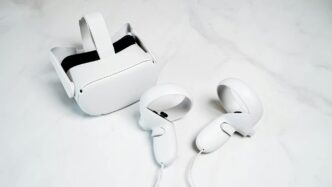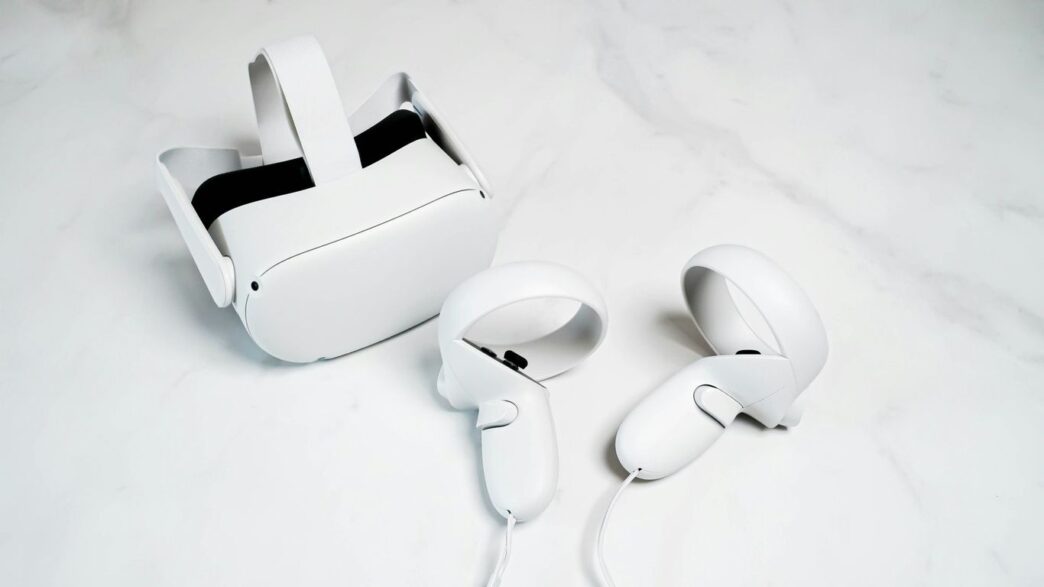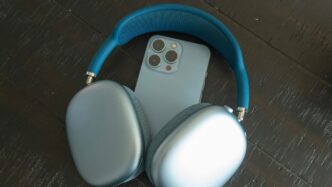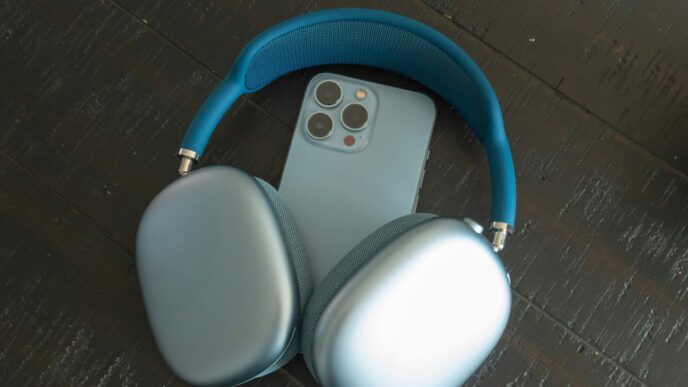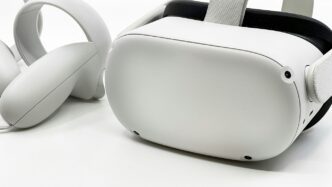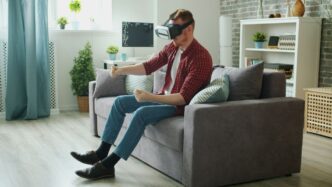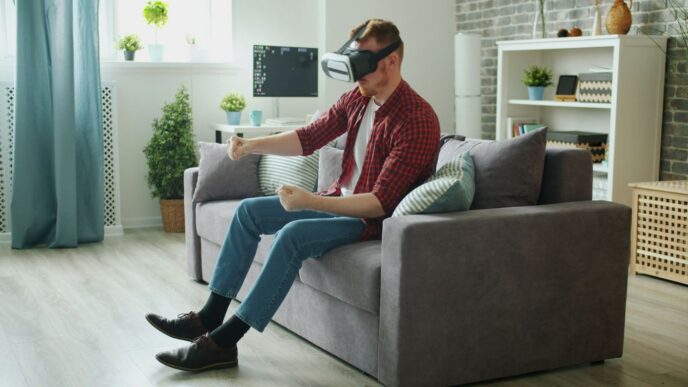So, the big question on everyone’s mind is: Apple Vision Pro versus Meta Quest 3. Which one is actually worth your hard-earned cash? It’s like comparing a souped-up sports car to a really solid family sedan. Both get you somewhere cool, but they do it in totally different ways, and boy, do they cost different amounts. We’re going to break down what makes each of these headsets tick, so you can figure out which one fits your life best. Let’s get into it.
Key Takeaways
- The Apple Vision Pro is a high-end, AR-focused device with top performance and Apple ecosystem integration, but its high price makes it a niche product for professionals and enthusiasts.
- The Meta Quest 3 is a more affordable mixed-reality headset, ideal for gaming and entertainment, offering good visuals and performance for the price.
- While the Vision Pro boasts superior display technology (micro-OLED) and a more advanced AR approach, the Quest 3 provides a strong mixed-reality experience with a focus on accessibility.
- Performance-wise, Apple’s M2 and R1 chips in the Vision Pro are more powerful, but the Quest 3’s Snapdragon XR2 Gen 2 is optimized for VR gaming and sufficient for most users.
- Ultimately, the apple vision pro vs meta quest 3 decision hinges on your budget and primary use case: premium AR integration and productivity for the Vision Pro, or accessible VR gaming and entertainment for the Quest 3.
Apple Vision Pro Versus Meta Quest 3: An Overview

Alright, so we’ve got two big players in the whole virtual and augmented reality scene right now: Apple’s Vision Pro and Meta’s Quest 3. It’s kind of a big deal because both companies are really pushing what these headsets can do, and honestly, they’re aiming for slightly different things. It’s not just about strapping screens to your face anymore; it’s about how we interact with digital stuff and our own world. These devices are shaping up to be pretty important for how we might work, play, and just generally hang out in the future. Let’s break down what makes each one tick and who they might be for.
Defining The Immersive Experience
When we talk about immersive experiences, we’re really talking about how well a headset can trick your senses into believing you’re somewhere else, or how it can blend digital things into your actual surroundings. For the Vision Pro, Apple is really pushing this idea of ‘spatial computing.’ Think of it like having your computer screens float around you in your room, but way more advanced. You can interact with apps and content using your eyes, hands, and voice. It’s meant to feel super natural, almost like an extension of your own mind. Meta’s Quest 3, on the other hand, is also about blending worlds, but it leans more into what they call ‘mixed reality.’ This means you can see your real room through the headset’s cameras, but digital objects and characters can appear and interact within that space. It’s great for games where monsters might pop out of your actual walls, or for having virtual furniture in your living room.
Key Differentiators In The Headset Market
So, what really sets these two apart? Well, a few things jump out immediately. First off, there’s the price. Apple’s Vision Pro is definitely in the luxury category, costing thousands of dollars. It’s built with premium materials and has some seriously high-tech features. Meta’s Quest 3 is much more affordable, making it accessible to a lot more people who just want to try out VR and AR without spending a fortune. Then there’s the whole ecosystem thing. Apple’s headset is deeply tied into Apple’s world – think of how your iPhone works with your Mac. The Vision Pro is designed to work with your existing Apple apps and services. Meta’s Quest 3 is more of a standalone device, but it connects to Meta’s own platforms and has a huge library of games and apps, especially for VR. It’s also more focused on gaming and social experiences.
Understanding The Core Technologies
Under the hood, both headsets are packing some serious tech, but they use different approaches. The Vision Pro uses Apple’s own M2 chip, which is the same kind of powerful processor found in their laptops, plus another chip called the R1 that’s specifically for handling all the sensor data super fast. This means it can do really complex stuff with augmented reality. The Quest 3 uses a Qualcomm Snapdragon chip, which is also very capable, especially for VR gaming. It’s designed to run smoothly and handle the demands of virtual worlds. Both have advanced displays and cameras, but the way they process information and what they prioritize – like Apple’s focus on AR and Meta’s on VR and mixed reality – really shapes the experience you get.
Design And Comfort: A Tale Of Two Headsets
When you’re strapping on a piece of tech that’s going to sit on your face for a while, how it feels and looks really matters. It’s not just about the fancy screens or the powerful chips; it’s about whether you’ll actually want to wear it. Apple and Meta have taken pretty different paths here, and it shows.
Apple’s Vision Pro definitely leans into that high-end, almost jewelry-like feel that Apple is known for. It’s got this sleek, curved glass front that looks super modern, paired with a lightweight aluminum frame. They’ve used this really soft, breathable fabric on the inside, which is a nice touch for comfort. It feels less like a gadget and more like a carefully crafted piece of tech. It’s clear Apple spent a lot of time making this look and feel expensive.
Meta’s Quest 3, on the other hand, feels more like a familiar evolution. If you’ve seen or used a Quest 2, you’ll recognize the general shape. It’s slimmer and lighter than its predecessor, which is a good step. It doesn’t have the same ‘wow’ factor in terms of materials as the Vision Pro, sticking with more standard plastics. But, it’s designed to be practical and functional, which makes sense given its price point.
Ergonomics And Extended Wearability
This is where things get interesting. Apple’s Vision Pro has a modular fit system. This means you can swap out headbands and cushions to get a really custom fit. They’ve also put a lot of effort into making sure it balances well, though some early testers did mention it can feel a bit front-heavy after a while. The idea is that this customizability should make it comfortable for longer sessions.
The Quest 3 has an adjustable strap, which is pretty standard. It’s comfortable enough for most people, especially for shorter bursts of gaming or watching something. However, it doesn’t offer the same level of personalized fit as the Vision Pro. Weight distribution is also a consideration; the Quest 3 is lighter overall, and many find its balance to be quite good for extended use, even if the materials aren’t as premium.
Materials And Build Quality Comparison
Let’s break down what these things are actually made of:
- Apple Vision Pro:
- Aluminum frame
- Curved glass front
- High-quality, soft fabric for facial interface
- Premium feel throughout
- Meta Quest 3:
- Plastic chassis
- Fabric straps (nylon and polyester)
- More utilitarian, durable build
- Designed for practicality over luxury
While the Vision Pro feels like a luxury item, the Quest 3 is built to be a workhorse. It’s a trade-off between a high-end experience and something that’s more accessible and perhaps a bit more robust for everyday knocks and bumps.
Display And Visual Fidelity: Seeing Is Believing
When you put on a headset, the first thing you notice is what you see. It’s all about the screens and how they show you the world, whether it’s a made-up place or your own living room with some digital stuff added. Both the Apple Vision Pro and the Meta Quest 3 have different approaches here, and it really changes the experience.
Pixel Density And Resolution Showdown
Apple went all out with the Vision Pro’s displays. They’re using micro-OLED screens, and each eye gets a resolution that adds up to a crazy 23 million pixels in total. This means things look incredibly sharp and clear, almost like you’re looking through a window rather than at a screen. It’s designed to make digital objects blend into your real surroundings so well, you might forget they aren’t actually there. The Quest 3, on the other hand, uses pancake lenses and offers 2,064 by 2,208 pixels for each eye. That’s still really good, giving you a sharp picture, but it doesn’t quite reach the same super-fine detail as the Vision Pro. It’s a noticeable difference if you’re looking for that absolute crispness.
Micro-OLED Versus Pancake Lenses
The technology behind the screens and lenses matters a lot. The Vision Pro’s micro-OLED displays are a big part of its visual punch. They can get very bright and show deep blacks, which makes colors pop and images feel more real. The Quest 3 uses pancake lenses, which are a more common design in VR headsets now. They help make the headset slimmer and can provide a clear image across a wider area. While pancake lenses are great for making the headset more comfortable and reducing bulk, the micro-OLED tech in the Vision Pro is what really pushes the visual quality to a higher level.
Augmented Reality Integration In Visuals
How these headsets handle augmented reality (AR) is a key difference. The Vision Pro is built from the ground up with AR as a main focus. It uses its cameras to show you the real world with digital elements layered on top. This is meant to feel very natural, like the digital information is just part of your environment. The Quest 3 also does mixed reality, letting you see your surroundings and interact with virtual objects. It’s good for games and experiences where you want to mix the digital and physical. However, the Vision Pro aims for a more sophisticated blend, making the digital overlays feel more integrated and less like a separate layer.
Here’s a quick look at some of the display specs:
| Feature | Apple Vision Pro | Meta Quest 3 |
|---|---|---|
| Display Type | Micro-OLED | LCD |
| Resolution (per eye) | ~4K equivalent (23 million pixels total) | 2,064 x 2,208 |
| Pixel Density | Very High | 1,218 PPI |
| Lens Type | Custom Optics | Pancake Lenses |
Performance And Processing Power
When you’re talking about these high-tech headsets, the brains behind the operation are super important. It’s what makes everything run smoothly, from simple menus to really complex virtual worlds. Both the Apple Vision Pro and the Meta Quest 3 have some serious hardware, but they’re built with different goals in mind.
Apple’s M2 And R1 Chips
Apple really went all out with the Vision Pro’s internals. It’s packing the M2 chip, which is the same kind of processor you’d find in their newer MacBooks. That’s a big deal because it means the Vision Pro can handle some pretty heavy lifting. On top of that, there’s a special R1 chip. This little guy is dedicated to processing all the information coming in from the headset’s cameras and sensors. This dual-chip setup is designed to make sure everything feels instant and fluid, with no lag. Think super-fast reactions and smooth visuals, even when you’re doing a bunch of things at once or running demanding AR apps.
Qualcomm Snapdragon XR2 Gen 2
The Meta Quest 3 uses the Qualcomm Snapdragon XR2 Gen 2. Now, this chip is no joke; it’s a big step up from what was in the Quest 2. It’s built specifically for VR and AR, and it does a really good job of making games and virtual experiences look and feel great. While it might not have the raw power of Apple’s M2 for general computing tasks, it’s highly optimized for what most people use VR headsets for – gaming and immersive entertainment. It’s designed to give you a solid, lag-free experience without needing the same kind of massive processing power that Apple is aiming for with the Vision Pro’s productivity focus.
Real-Time Sensor Processing
This is where those specialized chips really shine. Both headsets have a ton of cameras and sensors to track your eyes, hands, and the space around you. The Vision Pro’s R1 chip is specifically built to handle all that data in real-time. It’s like having a dedicated assistant just for managing sensor input, which helps keep the main M2 chip free to run your apps. The Quest 3 also has to process a lot of sensor data, and its Snapdragon chip is designed to do that efficiently. This processing is what allows for things like accurate hand tracking and making sure the virtual objects you see stay put in your real environment. Without good real-time processing, the whole experience would feel janky and disconnected.
Augmented And Mixed Reality Capabilities
When we talk about augmented and mixed reality, these headsets really start to show their different personalities. Apple Vision Pro is built from the ground up with augmented reality in mind. Think of it as a digital overlay for your actual world. It uses a bunch of cameras and sensors to show you your surroundings in full color, and then it can place digital stuff right into that view. You might see a movie playing on your wall or have a video call where the other person looks like they’re in the room with you. It’s all about blending digital elements with your physical space in a really convincing way.
Meta Quest 3, on the other hand, leans more into mixed reality, which is a bit of a blend. It also has cameras that let you see your room, but it’s more about mixing virtual objects into your real environment. So, you could be playing a game where virtual characters run around your actual living room. While it can do AR, its main focus seems to be on making VR games and experiences more interactive with your surroundings, rather than making your whole day-to-day digital life appear in your room.
Here’s a quick look at how they stack up:
- Apple Vision Pro: AR-first approach, aiming to integrate digital content into everyday tasks and experiences. It prioritizes a high-fidelity view of your surroundings with digital overlays.
- Meta Quest 3: Mixed reality focus, blending virtual elements with the real world, often for gaming and entertainment. Its passthrough is functional but might not be as crystal clear as Vision Pro’s.
The Vision Pro’s AR capabilities feel like a step towards making digital information a natural part of your environment, while the Quest 3 is more about bringing virtual worlds into your physical space for fun.
Software Ecosystems And Content Libraries

When you’re looking at something like the Apple Vision Pro or the Meta Quest 3, it’s not just about the hardware. The software, and what you can actually do with it, is a huge part of the picture. It’s like buying a game console – you need games to play, right?
VisionOS And The Apple Ecosystem
Apple’s approach with the Vision Pro is pretty much what you’d expect: it’s all about fitting into their existing world. Think of it as an extension of your iPhone or Mac, but in 3D. You’ll find familiar apps like Messages, Photos, and Safari, all redesigned for this new spatial environment. The big idea here is that your digital life can now exist all around you. It’s not just about VR games; Apple is pushing this as a tool for productivity and everyday tasks, too. You can use it as a giant, virtual display for your Mac, which is pretty neat if you’re tired of looking at multiple monitors. This tight integration means if you’re already deep into Apple’s services, the Vision Pro might feel like a natural next step. It’s a bit of a closed garden, though, so don’t expect to easily run apps from other platforms.
Horizon OS And Meta’s Content
Meta’s Quest 3 runs on Horizon OS, and their strategy is a bit different. They’ve been in the VR game for a while, and their focus has always been on making VR accessible and fun. You’ve got a massive library of games, many of which are standalone hits you can play right out of the box. Plus, the Quest 3 can connect to a PC, opening up a whole universe of PC VR titles through platforms like SteamVR. This makes it a really flexible option for gamers. Meta also has its own social VR spaces, like Horizon Worlds, where you can hang out with friends and play games. It feels more open in some ways, with more options for connecting to different types of content, including a lot of entertainment-focused apps.
Productivity Versus Entertainment Focus
So, where do they really stack up?
- Apple Vision Pro: Leans heavily into productivity and spatial computing. It’s designed to blend your digital work and personal life into your physical space. Think virtual monitors, 3D design work, and immersive media consumption that feels more integrated into your room.
- Meta Quest 3: While it can do productivity, its bread and butter is entertainment and gaming. It offers a vast library of VR games and experiences, and its mixed reality features are great for bringing digital elements into your real-world play.
It really comes down to what you want to do. If you’re looking for a device that feels like a futuristic upgrade to your computer and fits neatly into your Apple setup, the Vision Pro is aiming for you. If you want a more traditional, versatile VR headset that excels at gaming and offers a wider range of experiences, the Quest 3 is probably the way to go. Both are pushing boundaries, but in pretty different directions.
Price Point And Market Accessibility
The Premium Price Of Vision Pro
Alright, let’s talk about the elephant in the room: the price. The Apple Vision Pro is, to put it mildly, expensive. We’re talking a starting price that’s well into the thousands of dollars. This isn’t a casual purchase for most people; it’s a serious investment. Apple has positioned this device as a high-end piece of technology, and the cost definitely reflects that. It’s clear they’re targeting a specific audience here, one that’s less sensitive to price and more focused on having the absolute latest and greatest tech, especially if they’re already deep in the Apple ecosystem. It feels like a device for early adopters, professionals, or those who just really, really want to experience what Apple thinks the future of computing looks like.
Quest 3’s Value Proposition
Now, compare that to the Meta Quest 3, and the difference is pretty stark. The Quest 3 comes in at a much more approachable price point. You can get started with it for a few hundred dollars, which is a huge deal. This makes it accessible to a much wider range of people. Whether you’re a gamer looking for a new way to play, or just curious about VR and mixed reality without breaking the bank, the Quest 3 is a really solid option. Meta seems to be aiming for the mainstream here, trying to bring these immersive technologies to more homes. It’s about offering a good experience at a price that doesn’t require taking out a second mortgage.
Target Audiences For Each Device
So, who are these headsets really for? It breaks down pretty clearly based on the price and what each device offers.
- Apple Vision Pro: This is for the Apple loyalist, the professional who needs cutting-edge spatial computing tools, or the tech enthusiast with a significant budget. Think developers, designers, or anyone who wants to integrate their digital life into a new spatial dimension and is already invested in Apple’s services.
- Meta Quest 3: This headset is for gamers, VR newcomers, families, and anyone looking for an affordable entry into immersive entertainment and social experiences. It’s for people who want to play games, watch movies in VR, or try out social VR apps without a massive financial commitment.
- Mixed Audience: There’s also a growing group of people who might be interested in both for different reasons. Someone might own a Quest 3 for gaming and fun, but be eyeing the Vision Pro for specific work tasks or to see Apple’s take on spatial computing. The market is definitely splitting, with clear leaders in different price brackets and use-case focuses.
Use Cases And User Experience
So, what can you actually do with these things? It’s a big question, and the answer really splits the Apple Vision Pro and the Meta Quest 3.
Gaming And Entertainment Options
For gaming, the Quest 3 is still the king of the hill, no question. It’s built for it, with a huge library of VR games that just pull you right in. Think about jumping into a fantasy world or battling aliens – the Quest 3 makes that feel real. The Vision Pro? It’s not really set up for traditional gaming right now. You can watch movies on a massive virtual screen, which is pretty cool, and maybe play some simpler games, but it’s not its main gig. It’s more about experiencing content in a new way, like having a private cinema.
Productivity And Everyday Tasks
This is where the Vision Pro shines. Apple is pushing this as a spatial computer. Imagine having multiple big screens floating in front of you, all controlled by your eyes and hands. You can work on documents, browse the web, and even do some coding without being stuck at a desk. It feels like the future of how we might work. The Quest 3 can do some work stuff too, with apps for productivity, but it’s not as polished or as integrated into a workflow as what Apple is aiming for. It’s more of an add-on than a core function.
Spatial Computing Versus Immersive VR
Ultimately, it comes down to what you want. The Vision Pro is all about spatial computing, blending your digital life with the real world in a way that feels natural. It’s about augmenting your reality, not replacing it. The Quest 3, while it does mixed reality well, is still deeply rooted in full virtual reality. It’s for when you want to escape into another world, play games, or have fully immersive experiences. Think of it like this:
- Apple Vision Pro: Your digital world layered onto your real world.
- Meta Quest 3: A portal to entirely new virtual worlds.
It’s a big difference in how you’ll use them day-to-day. One is about making your current reality better, the other is about stepping into a completely different one.
So, Which Headset Wins?
Alright, so we’ve looked at both the Apple Vision Pro and the Meta Quest 3. It’s pretty clear they’re aiming for different people. If you’ve got a lot of cash and you’re deep in the Apple world, the Vision Pro is like a super fancy extension of your iPhone and Mac. It’s got amazing screens and feels really high-tech. But man, that price tag is something else. For most of us, the Quest 3 is the way to go. It’s way more affordable, still looks good, and is a blast for games and just messing around in VR. It’s not as fancy as the Vision Pro, especially for the augmented reality stuff, but it gets you into the immersive world without emptying your bank account. So, really, it just comes down to what you want to do and how much you’re willing to spend.
Frequently Asked Questions
What is the main difference between Apple Vision Pro and Meta Quest 3?
The Apple Vision Pro is like a super fancy computer for your eyes that works best with the real world around you, showing digital stuff layered on top. It’s great for work and seeing things in amazing detail. The Meta Quest 3 is more for jumping into virtual worlds for games and fun, and it can also show you digital things in your real room, but not quite as smoothly as the Vision Pro. Think of Vision Pro as a high-tech window and Quest 3 as a doorway to different places.
Which headset is better for gaming?
For a wide variety of games and a more traditional virtual reality gaming feel, the Meta Quest 3 is generally the better choice. It has access to a huge library of VR games and can even connect to a PC for even more options. The Apple Vision Pro can play some games, but it’s more focused on being a ‘spatial computer’ for other tasks, and some games might feel more like watching a big screen than being totally inside the game.
Is the Apple Vision Pro really worth the high price?
The Apple Vision Pro costs a lot more than the Meta Quest 3, starting at thousands of dollars. It’s built with super high-quality materials and has amazing screen technology, making digital things look incredibly real. It’s best for people who really want the absolute best in augmented reality, are deep into Apple’s other products, and have the money to spend. For most people, the Quest 3 offers a lot more bang for their buck.
Can I use both headsets for work and everyday tasks?
Yes, both can be used for some work and daily tasks, but they do it differently. The Apple Vision Pro is designed to be a powerful tool for productivity, letting you use apps like you would on a computer but in a 3D space. The Meta Quest 3 can also do some work stuff, especially with apps from Microsoft, but it’s more geared towards entertainment and gaming. If work is your main goal, the Vision Pro might be better, but the Quest 3 can still help.
How comfortable are these headsets to wear for a long time?
Both headsets try to be comfortable, but they feel different. The Apple Vision Pro uses fancy materials and has a design that aims for a really good fit, but some testers found it a bit heavy. The Meta Quest 3 is lighter and feels more familiar to wear, especially for its price. What feels most comfortable can really depend on your head shape and how long you plan to wear it.
Which headset has better screens and visuals?
The Apple Vision Pro has incredibly sharp and detailed screens, making the virtual and digital images look super realistic. It uses special Micro-OLED screens that show a lot of tiny dots (pixels). The Meta Quest 3 also has very good screens with its own special lenses, making things look clear and bright, especially for games. While the Vision Pro’s screens are technically more advanced, the Quest 3 still provides a great visual experience for its price.

